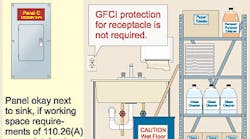All questions and answers are based on the 2005 NEC.
Q. Is GFCI protection required for a 15A or 20A, 125V receptacle that is located within 6 feet of a janitorial closet sink in a commercial building?
A. No. However, GFCI protection is required for all 15A and 20A, 125V receptacles located within 6 feet of a dwelling unit utility sink [210.8(A)(7)]. (Figure)
Q. I'm working in a facility that contains a small data center for a customer call center. The CATV, telephone, and satellite dish are individually grounded to standalone ground rods. The designer claims that the individual ground rods are not required to be grounded to the building grounding electrode system. Is this true?
A. No. The NEC requires all communications systems on or in a structure to be grounded to the building grounding electrode system. Requirements are noted in the following sections:
-
Communications Systems (Telephone) — 800.100
-
Radio and Television Equipment (Satellite) — 810.21
-
Community Antenna Television and Radio Distribution Systems — 820.100
-
Network-Powered Broadband Communications Systems — 830.100
The purpose of grounding all systems to the same electrode (basically bonding the systems together) is to reduce differences in potential between communications circuits and the power system during a lightning event.
Q. What are the NEC requirements for the installation of a transfer switch ahead of the service disconnecting means?
A. You're not permitted to install a transfer switch on the supply side of the service disconnecting means unless it's rated “suitable for use as service equipment” (i.e. transfer switch containing a disconnecting means) [230.66 and 230.82].
Q. My buddy told me that a GFCI- or AFCI-protected circuit can't be used to supply power to a GFCI receptacle. Is this true?
A. No. GFCIs and AFCI protection devices will operate just fine if supplied by a GFCI- or AFCI-protected circuit.
Q. Can a flexible cord with an attachment plug be located below the raised floor of an information technology equipment (ITE) room?
A. Maybe. Flexible cords under the raised floor of an ITE room are permitted, but the cable must have adequate fire-resistant characteristics suitable for this use. To meet this requirement, the cable must be listed as Type DP (Data Processing) [645.5(D)(5)].
Q. Can an optional standby generator be connected to premises wiring by the use of an extension cord having double male attachment plugs?
A. No. The Code requires all fixed or portable optional standby power systems be connected to the premises via a transfer switch [702.6]. In addition, attachment plugs can only be installed in a way that ensures their prongs, blades, or pins are not energized unless inserted into an energized receptacle [406.6(B)].
Q. I came across some 120V utility wiring for a metal light pole. I told the lineman that the NEC requires the metal cover of the handhole and metal pole to be bonded so that dangerous touch voltage from a ground fault would be removed by the opening of the circuit protection device.
His response to me was, “We are not required to comply with the NEC. This installation is safe because the metal cover and pole are grounded to a ground rod.” Is this true?
A. The lineman is correct in that his installation is not required to comply with the NEC [90.2(B)(5)]. He's also correct when he says the National Electric Safety Code (an electric code for utilities) does not require the metal parts of this installation to be bonded to an effective ground-fault current path with the purpose of clearing a ground fault.
Is the utility installation safe? In my opinion, no. Many individuals have died making contact to energized metal parts that are grounded to the earth, but not bonded to an effective ground-fault path, as required by 250.4(A)(3).
Q. Is GFCI protection required for a pool pump motor circuit?
A. GFCI protection is not required for hardwired circuits that supply pool pump motors. However, receptacles rated 15A or 20A, single phase, that supply cord-connected pool pump motors must be GFCI protected [680.22(A)(5)].
Note: The outlet that supplies a self-contained indoor spa or hot tub, a packaged spa or hot tub equipment assembly, or a field-assembled spa or hot tub must be GFCI protected [680.44]. Because this rule applies to all outlets and not just receptacle outlets, the wiring for a hardwired self-contained indoor spa or hot tub, a packaged spa, or hot tub equipment assembly would require GFCI protection.
Q. What type of wiring can I use for 70V speaker circuits? The rear of the amplifying equipment states “Class 2 wiring permitted.”
A. Because the amplifying equipment specifies that Class 2 circuit wiring is permitted, you can use any Class 2 cable — or any of its permitted substitutions — in accordance with 725.61.
Q. Can single-pole circuit breakers be used for a multiwire branch circuit that supplies power for office partitions?
A. Yes, as long as the individual single-pole circuit breakers use handle ties that are identified for the purpose [240.20(B)(1) and 605.6]. A common internal trip circuit breaker could be used for this application as well, but all of the individual branch circuits will open in the event of a ground fault in only one of the circuits.




